French Walnut Dining Table with Carved Tripod Base
A 19th century French walnut circular drum top dining table, with bobbin turned frieze beneath the top edge, fluted column pedestal and an elaborately carved leaf and scroll tripod base, width 118 cm, height 75 cm.
You must be a subscriber, and be logged in to view price and dealer details.
Subscribe Now to view actual auction price for this item
When you subscribe, you have the option of setting the currency in which to display prices to $Au, $US, $NZ or Stg.
This item has been sold, and the description, image and price are for reference purposes only.
- Tripod Base - A type of base used on small tables in the 18th and 19th century, consisting of either a stem to a three legged pillar, or three legs attached to the top. The former was derived from the candle stand, which has a small top and a long stem, terminating in the three legged pillar.
In the 19th century this type of base was popular on wine and occasional tables, and its use extended into larger centre, breakfast and drum tables. - Fluting - A form of decoration found on many pieces of furniture, as well as ceramics, silver and clocks, in which round-bottomed grooves, of varying width and depth, are let into columns, pilasters, legs. As a general rule, flutes are cut in the vertical, though they may follow a turned leg in a spiral pattern. In cross-section, they may be described as a series of 'U' shapes, rising and narrowing at each end of the groove. Fluting is the opposite of reeding, with which fluting is often associated.
- Turning - Any part of a piece of furniture that has been turned and shaped with chisels on a lathe. Turned sections include legs, columns, feet, finials, pedestals, stretchers, spindles etc. There have been many varieties and fashions over the centuries: baluster, melon, barley-sugar, bobbin, cotton-reel, rope-twist, and so on. Split turning implies a turned section that has been cut in half lengthwise and applied to a cabinet front as a false decorative support.
- Bobbin Turning - This turning resembles a series of compressed spheres, not unlike a row of beads or bobbins. Commonly associated with Jacobean-style furniture, bobbin turning is also found on a wide variety of small cedar and pine tables and washstands made in Australia during the late 19th century and up to the first world war.
- Column - An architectural feature sometimes used for decorative effect and sometimes as part of the supporting construction. Columns should generally taper slightly towards the top. They may be plain or decorated with carving, fluting or reeding. Columns may be fully rounded or, more commonly, half-rounded and attached with glue, screws or pins to the outer stiles of doors, or the facing uprights on cabinets and bureaux.
- Frieze - An architectural term denoting the flat, shaped or convex horizontal surface of furniture, between the architrave and the cornice, usually found on a cabinet or bookcase, or on desks and tables where it may include drawers, the area between the top and the legs. In ceramics, the term refers to the banding, of usually a repeating pattern, on the rims of plates and vases.
This item has been included into following indexes:
- tables, French - French, wine and ocasional 548
-
tables, purpose or type
- drum 45
- pedestal, side and centre 140
- tables, small, period or style - tripod 181
Visually similar items

An American oak circular dining table height 76 cm, 131 cm diameter cm
Sold by
in
for
You can display prices in $Au, $US, $NZ or Stg.

A Victorian walnut loo table, quartered veneer top with tilt mechanism, raised on a carved pedestal base. 123 cm x 90 cm x 74 cm
Sold by
in
for
You can display prices in $Au, $US, $NZ or Stg.

William IV table, circular rosewood, with large pedestal base, claw feet, diameter 132 cm
Sold by
in
for
You can display prices in $Au, $US, $NZ or Stg.

A Victorian oval loo table, with satin wood inlay
Sold by
in
for
You can display prices in $Au, $US, $NZ or Stg.
